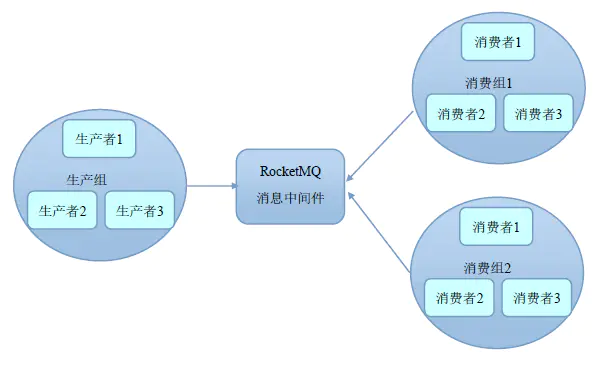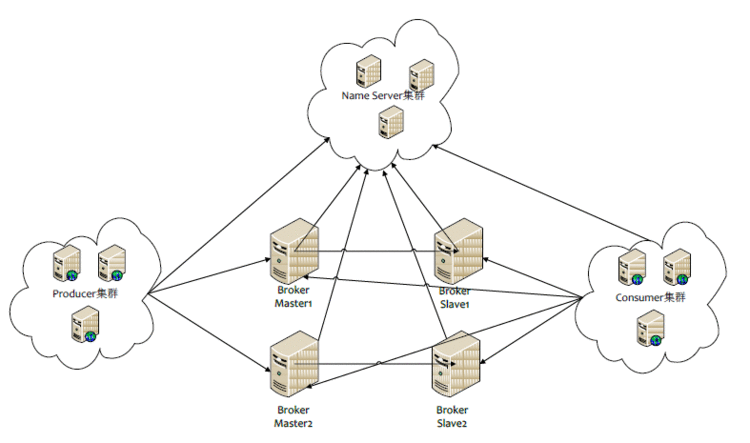本系列文章主要介绍 RocketMQ 的相关知识,并通过示例代码介绍 RocketMQ 的使用方法。
本文为系列文章的第一篇,主要介绍 RocketMQ 的概要知识。
说明:本文的部分内容参考了 https://www.jianshu.com/p/3afd610a8f7d 文章的相关内容。
首先,给出 GitHub 上 RocketMQ 项目的描述,内容如下:
Apache RocketMQ is a distributed messaging and streaming platform with low latency, high performance and reliability, trillion-level capacity and flexible scalability.
It offers a variety of features:
- Pub/Sub messaging model
- Scheduled message delivery
- Message retroactivity by time or offset
- Log hub for streaming
- Big data integration
- Reliable FIFO and strict ordered messaging in the same queue
- Efficient pull&push consumption model
- Million-level message accumulation capacity in a single queue
- Multiple messaging protocols like JMS and OpenMessaging
- Flexible distributed scale-out deployment architecture
- Lightning-fast batch message exchange system
- Various message filter mechanics such as SQL and Tag
- Docker images for isolated testing and cloud isolated clusters
- Feature-rich administrative dashboard for configuration, metrics and monitoring
RocketMQ 作为一款分布式的消息中间件,经历了 Metaq1.x、Metaq2.x 的发展和淘宝双十一的洗礼,证明其在功能和性能上远超 ActiveMQ。GitHub 上关于 RocketMQ 诞生的原因中,也说明了随着交易量的大幅度增长,ActiveMQ 到达了性能瓶颈,而其他流行的消息解决方案(如 Kafka)都不能满足其需求的情况下,才诞生了 RocketMQ。
RocketMQ 的优点如下:
ActiveMQ 中并没有 Group 这个概念,而在 RocketMQ 中存在 Group 的机制,理解该机制对于深入理解 RocketMQ 非常重要。

RocketMQ 通过 Group 机制,天然地支持了消息负载均衡。例如,某个 Topic 有 9 条消息,其中一个 Consumer Group 有 3 个实例(3 个进程/3 台机器),那么每个实例将均摊 3 条消息,由此实现了负载均衡。(注意:RocketMQ 只有一种模式,即发布订阅模式)
RocketMQ 有多种 Broker 集群部署模式,常见的包括:单 Master 模式、多 Master 模式、多 Master 多 Slave 模式(异步复制)、多 Master 多 Slave 模式(同步双写)等。这里需要强调一下:RocketMQ 的 Slave 只能被消费者读取,不可以被生产者写入,类似于 MySQL 的主从机制。下面分别介绍这几种 Broker 集群部署模式。
很显然,单 Master 模式部署风险较大,一旦这个 Broker 重启或宕机,会导致整个服务不可用,通常线上环境都不会使用此模式。
集群中全是 Master,没有 Slave,例如 2 个 Master 或 3 个 Master。此时,如果某一个 Broker 重启或宕机,对应用是无影响的。此模式的缺点在于,当某个 Master 宕机时,该 Master 上未被消费的消息在 Master 恢复之前是不可以订阅的,消息的实时性会受到影响。
此模式下,有多个 Master,每个 Master 会配置一个或多个 Slave,由此实现了系统的高可用性。同时,Master 与 Slave 之间的消息同步,采用异步复制的方式,主备之间会短暂的消息延迟,这种延迟是 MS 级别的。如果 Master 宕机,消费者可以从 Slave 上进行消息消费,不影响消息实时性,但是由于 Master 的宕机,会导致丢失掉极少量(尚未同步到 Slave 上)的消息。
此模式下,有多个 Master,每个 Master 会配置一个或多个 Slave,由此实现了系统的高可用性。同时,Master 与 Slave 之间的消息同步,采用同步双写的方式,也就是在 Master 和 Slave 都写成功的前提下,才会向应用(生产者)返回成功。显然,此种模式下,无论是数据还是服务都不是单点的,所以服务与数据的可用性都非常高。此模式的缺点在于,性能会比异步复制稍低。
多 Master 多 Slave 模式的部署架构图,如下所示:

下面给出一张 RocketMQ、ActiveMQ 和 Kafka 的技术和特性的对比表,表内容如下:
| Messaging Product | Client SDK | Protocol and Specification | Ordered Message | Scheduled Message | Batched Message | BroadCast Message | Message Filter | Server Triggered Redelivery | Message Storage | Message Retroactive | Message Priority | High Availability and Failover | Message Track | Configuration | Management and Operation Tools |
|---|---|---|---|---|---|---|---|---|---|---|---|---|---|---|---|
| ActiveMQ | Java, .NET, C++ etc. | Push model, support OpenWire, STOMP, AMQP, MQTT, JMS | Exclusive Consumer or Exclusive Queues can ensure ordering | Supported | Not Supported | Supported | Supported | Not Supported | Supports very fast persistence using JDBC along with a high performance journal,such as levelDB, kahaDB | Supported | Supported | Supported, depending on storage,if using kahadb it requires a ZooKeeper server | Not Supported | The default configuration is low level, user need to optimize the configuration parameters | Supported |
| Kafka | Java, Scala etc. | Pull model, support TCP | Ensure ordering of messages within a partition | Not Supported | Supported, with async producer | Not Supported | Supported, you can use Kafka Streams to filter messages | Not Supported | High performance file storage | Supported offset indicate | Not Supported | Supported, requires a ZooKeeper server | Not Supported | Kafka uses key-value pairs format for configuration. These values can be supplied either from a file or programmatically. | Supported, use terminal command to expose core metrics |
| RocketMQ | Java, C++, Go | Pull model, support TCP, JMS, OpenMessaging | Ensure strict ordering of messages,and can scale out gracefully | Supported | Supported, with sync mode to avoid message loss | Supported | Supported, property filter expressions based on SQL92 | Supported | High performance and low latency file storage | Supported timestamp and offset two indicates | Not Supported | Supported, Master-Slave model, without another kit | Supported | Work out of box,user only need to pay attention to a few configurations | Supported, rich web and terminal command to expose core metrics |
首先介绍一下 Push 和 Pull 两种消费模式,内容如下:
介绍完一般的 Push 与 Pull 消费方式后,再来看一下 RocketMQ 的这两种消费方式,内容如下:
说明:RocketMQ 的 Push 方式本质上也属于 Pull 方式,因为当 Consumer 从 broker 成功获取到消息后,Consumer 需要调用监听器,主动去 broker 轮询拉取消息完成消费。这种 Push 方式既解决了普通的 Push 方式的“慢消费问题”,同时相对于纯 Pull 模式来说,在代码实现上又简单了许多。
正如上面的说明所述,RocketMQ 的消费方式(Pull 方式 和 Push 方式)本质上都是基于 Pull 方式的,即都是采用 consumer 轮询从 broker 拉取消息。而在轮询过程中,加入了一种长轮询机制(对普通轮询的一种优化),来平衡 Push/Pull 模型的各自缺点。长轮询机制的基本设计思路是:消费者如果第一次尝试 pull 消息失败(如 Broker 端没有可以消费的消息),Broker 并不立即给消费者客户端返回 Response 响应消息,而是先 hold 并挂起该请求(将请求保存至 pullRequestTable 本地缓存变量中),然后 Broker 端的后台独立线程 PullRequestHoldService 会从 pullRequestTable 本地缓存变量中不断地去取,具体的做法是查询待拉取消息的偏移量是否小于消费队列最大偏移量,如果条件成立则说明有新消息达到 Broker 端(这里,在 RocketMQ 的 Broker 端会有一个后台独立线程 ReputMessageService 不停地构建 ConsumeQueue/IndexFile 数据,同时取出 hold 住的请求并进行二次处理),则通过重新调用一次业务处理器 PullMessageProcessor 的处理请求方法 processRequest(),来重新尝试拉取消息(此处,每隔 5s 重试一次,默认长轮询整体的时间设置为 30s)。
RocketMQ 使用的这种长轮询机制(Pull 方式和 Push 方式都具有),解决了一般的 Push 方式的“慢消费问题”,同时,解决了一般的 Pull 方式的“消息延迟与忙等待问题”,并且,使用 RocketMQ 的 Push 机制,还可以减小消费者端的代码逻辑复杂度,所以 RocketMQ 的 Push 方式同时具有三个优点。
综上所述,在实际应用中,我们一般会采用 RocketMQ 的 Push 方式进行消息消费。
关于 RocketMQ 具体的部署方法,请参考本系列文章的第二篇。

 京公网安备 11010802041100号 | 京ICP备19059560号-4 | PHP1.CN 第一PHP社区 版权所有
京公网安备 11010802041100号 | 京ICP备19059560号-4 | PHP1.CN 第一PHP社区 版权所有